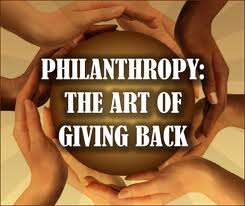 Easter was just a few days ago, and I still have things like fake basket grass, plastic eggs, and empty calories on my mind. I’ve also been working hard at turning leftover ham into split pea soup. Apparently, other bloggers have Easter on the brain because I just read a great post titled “Who’s Your Thomas?” that Tom Okarma posted on the Fox West Philanthropic Network’s LinkedIn discussion board. I loved this blog post because it was better than anything the Easter Bunny brought me . . . it was the gift of “AH-HA”.
Easter was just a few days ago, and I still have things like fake basket grass, plastic eggs, and empty calories on my mind. I’ve also been working hard at turning leftover ham into split pea soup. Apparently, other bloggers have Easter on the brain because I just read a great post titled “Who’s Your Thomas?” that Tom Okarma posted on the Fox West Philanthropic Network’s LinkedIn discussion board. I loved this blog post because it was better than anything the Easter Bunny brought me . . . it was the gift of “AH-HA”.
As you probably get from the title of the post, Tom talks about the value of having a board volunteer who is not a rubber stamp. In fact, this person actively doubts all sorts of things that your agency is about to undertake. They express their concerns. They ask questions . . . lots of them. They share what they believe is the “unvarnished truth” regardless of whether or not the timing is convenient.
When I was on the front line, my Doubting Thomas was a board member named Lee.
I wish I could tell you that I used Lee’s talents appropriately, but I cannot. I worked hard to silence him, and more than a decade later I now see how wrong I was.
Gosh darn it . . . hindsight really is cruel. LOL
 Guarding against the rubber stamp
Guarding against the rubber stamp
I cannot count how many times I’ve seen a group of people sit around a table, discuss an issue, and look like a bunch of bobble-head dolls. Let’s face it. People are busy and on any given day we can get distracted and fail to focus on the business at hand.
If you have “Board Member Thomas” sitting around the table, the odds are much higher that the bobble-head dolls might bobble at a slightly slower pace and fewer mistakes/oversights might be made.
Improving the decision
One of the things I’ve seen work when it comes to satisfying “Board Member Thomas” is answering their questions. This usually entails more than just verbally telling them what they want to know. It almost always involves data, reports, and documents. After receiving these things, it also almost always involves discussion, discussion and more discussion.
In the end, this information and discussion results in better boardroom decision-making.
Too much of a good thing is always bad
 On a few occasions, I’ve had the privilege of being in a non-profit boardroom full of Doubting Thomas board members. Just thinking about those few experiences still sends a chill up my spine. LOL Would you be surprised if I told you those boardrooms brought the expression “paralysis by analysis” to life?
On a few occasions, I’ve had the privilege of being in a non-profit boardroom full of Doubting Thomas board members. Just thinking about those few experiences still sends a chill up my spine. LOL Would you be surprised if I told you those boardrooms brought the expression “paralysis by analysis” to life?
There are two important points that need to be made here:
- Diversity is about more than just age, gender and ethnicity. It includes all kinds of other factors: profession/occupation, personal and career experiences/successes, social networks, and . . . yes . . . personality types (e.g. Doubting Thomas).
- The funny thing about diversity is that if you over-pursue one thing, then you end up losing your diversity. Target too many Millennial and GenX board prospects, and you end up with a young and ineffective board. If you recruit too many Doubting Thomas board volunteers, then you end up with grid lock. So, tread carefully!
Do you have a Doubting Thomas on your board? How do you manage that asset? How do you work with your board development or governance committee to identify and target such a board prospect? Do you have any Doubting Thomas boardroom stories to share with your peers? Please scroll down and use the comment box to share a thought or two on this very important board development topic. We can all learn from each other.
Here’s to your health!
Erik Anderson
Founder & President, The Healthy Non-Profit LLC
www.thehealthynonprofit.com
erik@thehealthynonprofit.com
http://twitter.com/#!/eanderson847
http://www.facebook.com/eanderson847
http://www.linkedin.com/in/erikanderson847















